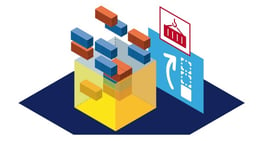5 Advanced Analytics Insights for 2021
Jesse Kelber - August 18, 2020

 The global digital transformation is gathering steam, and for manufacturing, that means the move to Industry 4.0 is also in full swing. With recent developments in cloud infrastructure technology it’s never been easier to deploy things like GPS trackers and IoT sensors up and down your supply chain. Add to this the maturation of artificial intelligence (AI) and machine learning and you can take full advantage of all the data being generated by your Industry 4.0 devices with advanced analytics. Only analytics engines powered by AI are capable of delivering the real-time, actionable insights you need to streamline your supply chain, maximize ROI, and stay one step ahead of the competition. In order to help set you on the course to realizing the full potential of advanced analytics, here are our picks for where to focus your attention.
The global digital transformation is gathering steam, and for manufacturing, that means the move to Industry 4.0 is also in full swing. With recent developments in cloud infrastructure technology it’s never been easier to deploy things like GPS trackers and IoT sensors up and down your supply chain. Add to this the maturation of artificial intelligence (AI) and machine learning and you can take full advantage of all the data being generated by your Industry 4.0 devices with advanced analytics. Only analytics engines powered by AI are capable of delivering the real-time, actionable insights you need to streamline your supply chain, maximize ROI, and stay one step ahead of the competition. In order to help set you on the course to realizing the full potential of advanced analytics, here are our picks for where to focus your attention.
1) Industry 4.0 Adoption Data Powers Analytics Initiatives
The 4th industrial revolution, commonly called Industry 4.0, is well and truly underway. As companies invest in upgraded infrastructure to support IoT devices, cloud-based ERP systems, and more, they’re also coming to realize the sheer volume of data these devices generate. Most have an understanding that this data contains insights that can help them improve the efficiency of their supply chain. The question that remains is just how to make use of all that data in order to actually reap the benefits buried in there.
And the answer to that question is advanced analytics. With connectivity becoming less and less of a barrier (5G is here in many areas), it’s possible for data from multiple dispersed locations around the world to pass data to a centralized analytics engine and have insights returned within a matter of moments. AI-powered analytics engines are capable of sorting and sifting terabytes of data nearly instantaneously, separating the signal from the noise. The resulting reports provide the actionable insights you need to tweak production here, redirect shipping there, and reap instant rewards in the form of increased ROI and decreased time-to-delivery.
2) Prescriptive Analytics Deliver Unprecedented Accuracy
Advanced analytics takes two primary forms: predictive and prescriptive. You’ll be familiar with the first since the basic concept is relatively unchanged from days past and analytics methods of old. Predictive analytics simply tell you what *should* happen next. Prescriptive analytics is the real game-changer. Why? Because it tells you what to do about it.
Need to know which plant to send the next order to? Unsure which route to have the trucks use tomorrow, seeing as how there’s a storm predicted for tonight? How about when to have maintenance done on that equipment in plant 3? The accuracy of these insights can be truly astounding, down to what time to have the technicians show up to work on that production machinery. These are just some of the insights prescriptive analytics can provide, and it’s all down to advanced analytics engines powered by machine learning and AI.
3) Advanced Analytics Won’t Eliminate Disruptions—But It Can Lessen Their Impact
The increased accuracy mentioned above is the root source of many benefits, not least among them the money you stand to save when you can avoid disruptions that leave your competition struggling. Think about it like this, if you know of a disruption ahead of time, you can lay out a plan to address it head-on:
- Reroute trucks around surprise closures
- Divert ships to a port with lower fuel prices
- Redirect shipments around the storm that’s wreaking havoc on shipping lanes
We’re not saying that analytics has the power to change global conditions that led to the disruption, far from it. What we are saying is simply that with the power of AI behind your decisions, you’re in a better position to make the changes yourself that will ensure you make it through the disruption unscathed.
4) Analytics Feed Digital Transformation
Remember how we said the global digital transformation was gathering steam? We may have understated it a bit. In reality, the explosion of emerging technologies, unheard of connectivity, and mass adoption of machine learning have combined to create the perfect storm, if you’ll forgive the pun. The combination of this technological adoption with the growing reliance on advanced analytics leads to a virtuous cycle where the analytics turn out insights that fuel further technologies, which then feed more analytics, and so on.
That cycle may look something like this: you deploy IoT sensors to the factory floor and trackers to your fleet of trucks. These send terabytes of production data to your datastore, which is then fed into your advanced analytics engine. The resulting insights tell you the optimal time to perform maintenance, the precise moment when an order will be ready to ship, and even where to reroute shipments for faster delivery. The next cycle is when you take the money you saved and put it into the next stage of your deployment—like moving your ERP to the cloud for better accessibility and visibility.
5) Industrial AI is Here to Stay
We’ve already covered several areas where AI is having an impact on the global supply chain’s ability to make use of all the data being generated by Industry 4.0 technology. In fact, AI is nearly synonymous with advanced analytics as the engines driving that analysis is powered by machine learning and AI itself. The next area we see AI impacting is demand planning.
Demand planning is all about knowing ahead of time what’s going to happen, whether that means upcoming product demand cycles, buying patterns, or global shipping route changes. And that’s precisely what AI does best, it feeds on historical data combined with current patterns and it generates predictions for the next phase in the cycle. And it does all of that in real-time so you can act on the insights created immediately for the greatest impact on your own bottom line. Advanced analytics helps you pivot and correct course in real-time—which is exactly what you need to not just survive, but thrive, in the current global economic climate.
LATEST POSTS
- Understand Circular Economy in The Manufacturing Industry
- How Can Industry 4.0 IT Integration Be Achieved Smoothly?
- The Significance of Order Sequencing in Discrete Manufacturing
- How to improve your Supply Chain Management: The Power of Control Towers
- Optimizing Human Resource Scheduling in Manufacturing: A Technological Approach



